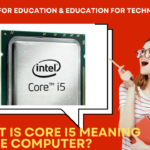•When we as a person use a computer system first time, often a curiosity develops in the mind that how this machine works actually?
•How it understands my words?
•How produce results very soon?
•And this curiosity brings many questions in our mind only because we are not having knowledge about the Computer background.
•Today we will share all, step by step, on the computer system’s working process.
What is a Computer
•Initially, what we know about Computer is that a computer is an electronic device that requires a power supply to work.
•A computer machine is used to process the information provided by us.
•It takes information or data from one end (Computer Input), store it to process.
•After completing the processing, it gives output (Computer output) the result on screen.
•The place where it stores the information is known as Computer Memory or RAM (Random Access Memory).
•A computer system stores information in bits.
•Bits is the smallest storage unit of a computer.
Major Components of a Computer
•A computer system works by combining input, storage space, processing, and output.
•Let’s understand one by one:
Input: An input is the information that we provide to the Computer. We provide the information using the Computer’s input devices: Keyboard, mouse, microphone, and many more. For example, when we type something using a keyboard, it is known as an Input provided to the Computer.
Storage Space: It is known as Computer Memory that stores the data into it. Other than RAM, a computer uses a hard drive for storing files and documents. It uses two types of memory, i.e., internal memory and external memory. Internal memory is known as RAM, which is volatile in nature. It stores data temporarily, i.e., when the data is ready to be processed, is loaded into RAM, and after processing, it moves data for the storage. On the other hand, external memory is used to store data permanently until you remove it or it got crashed.
Processing: The processing of the input is performed by the CPU, which is the Central Processing Unit of the Computer. It is also known as the brain of a computer that is responsible for processing the data provided by the user.
Output: When we type something using a keyboard, the place where we see the typed input is the Computer Monitor or Computer Screen. A computer screen allows seeing the input we provided to the Computer. Including this, there are different types of output devices of a computer, such as loudspeakers, projectors, printers, and many more.
•The input and output devices that can be physically touched are known as Hardware of the system.
•Such as keyboard, mouse, screen, etc.
•The Operating System and all the applications that runs in the Computer and can only see them but cannot touch them are known as Software.
•Such as Windows 10, Microsoft Word, Excel, Paint, and all the installed software on the system.
Now Time to Start a computer to work
•A POST (power-on self-test) is performed on the Computer in a sequence to ensure that the major computer components exist and work properly.
•When the Computer passes the test, firstly, the 64-bytes memory wakes because it carries the system time and date information and all other hardware-related information installed on the system.
•This information starts loading and POST checks and compares this information with the system settings in the BIOS.
•If compared successfully, it loads the basic drivers (that allows communication of hardware devices with CPU and Computer to continue to boot) and interrupts handlers for the installed Hardware such as a keyboard, hard drive, mouse, and many more.
•With no issues, all components come in their active state, the power supply sends a signal to the motherboard and CPU.
•During the time, the processor removes the leftover data in the memory, and the CPU becomes ready to take over the instruction (input) and process it.

•After that, POST checks the display adapter, and with no issues found, it loads the display that we see on the computer monitor.
•Next, it is checked that whether Cold boot or reboot (warm boot) is performed by looking at the memory address 0000:0472.
•If it is 1234h, it means it is a reboot, and the rest of the POST steps are skipped.
•But, if it not so, it means it is a cold boot, and the remaining POST steps are continued.
•Now, the RAM installed on the computer system is checked.
•At last, POST tests the optical drive and hard drive of the Computer by sending signals to them.
•When all drives successfully pass the test, the POST is finished and instructs to begin the loading of the OS.
•However, if the Computer fails in the POST test, an irregular POST is encountered.
•We can get the irregular POST when we hear a beep coming from the system that notifies us that some problem has occurred.
Operating System –
•The system’s booting process begins that load the operating system (Windows, Linux, Mac, etc.) with all associated files.
•The bootstrap loader starts the booting of the system.
•So, in this way, Windows and its other essential services get loaded to the system.
oThen installed Hardware of the systems becomes active and able to communicate with the CPU.
oThe communication of the hardware devices is performed via an interrupt request (IRQ).
oWhen the current task is already running, the interrupt controller sends the request to CPU to stop processing a new hardware request until the execution of the current task gets completed.
oThe CPU keeps the new request on hold, and that process is stored as a memory address in the memory stack.
•When the current task execution is finished, the task on hold is resumed and processed.















